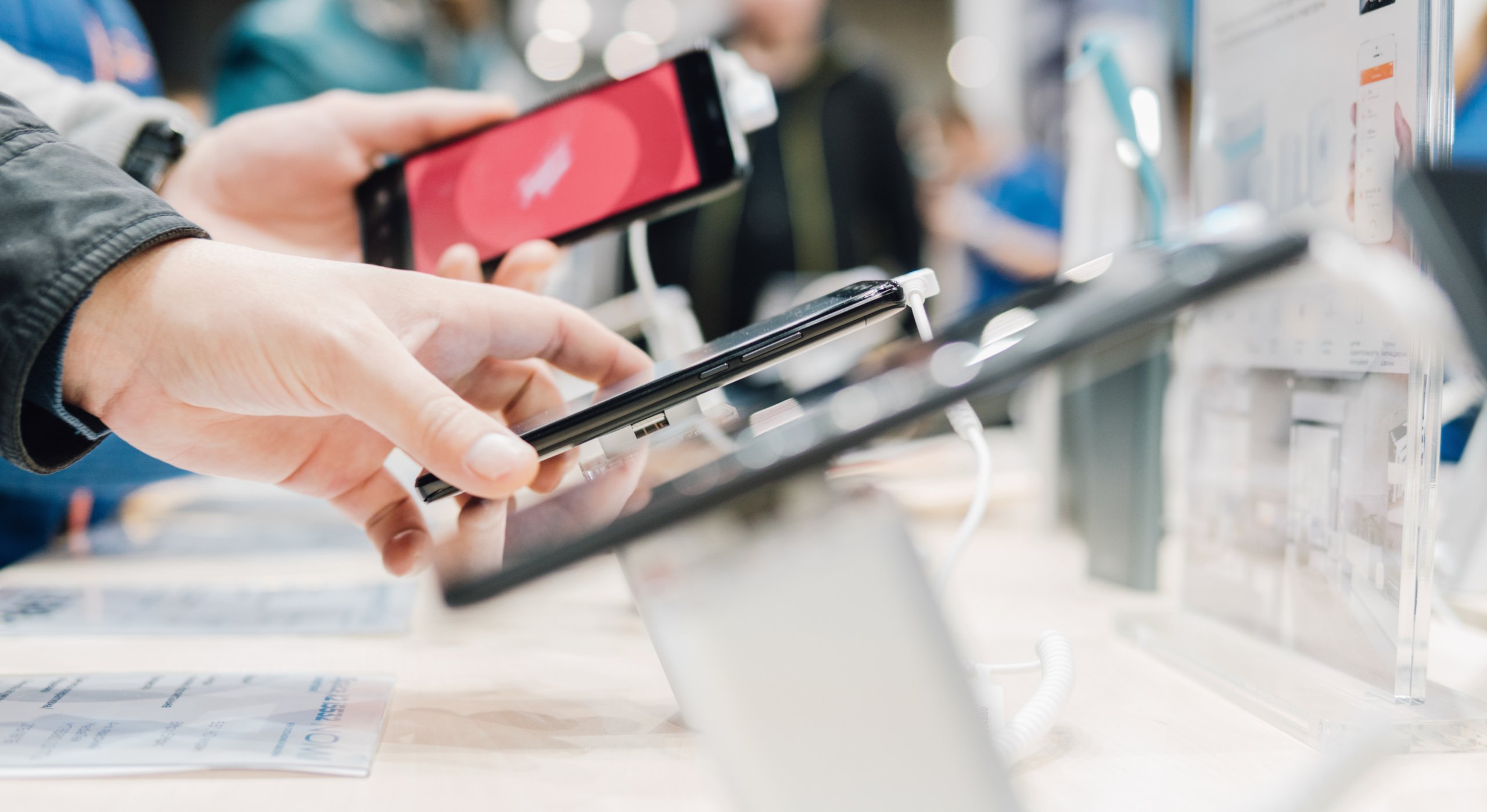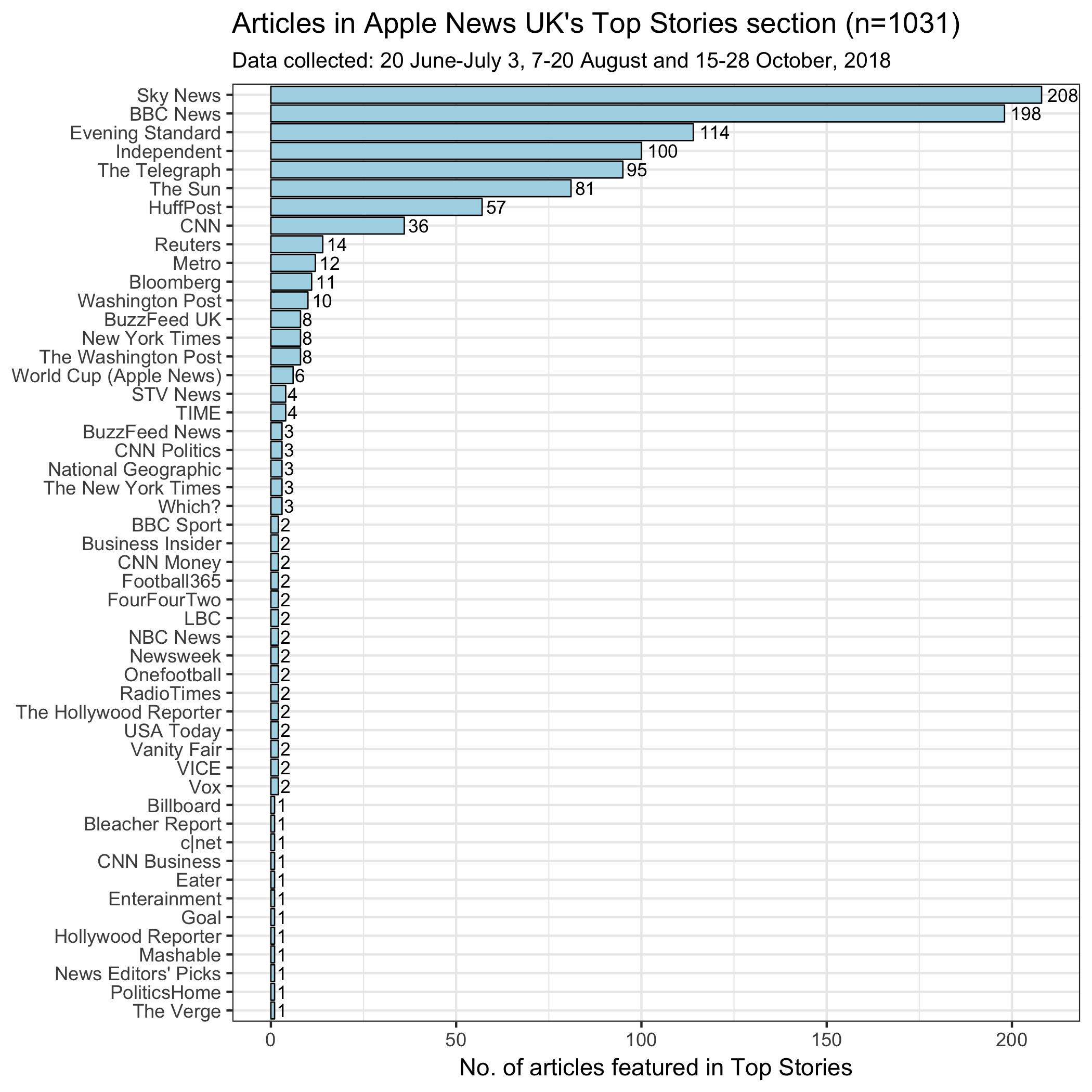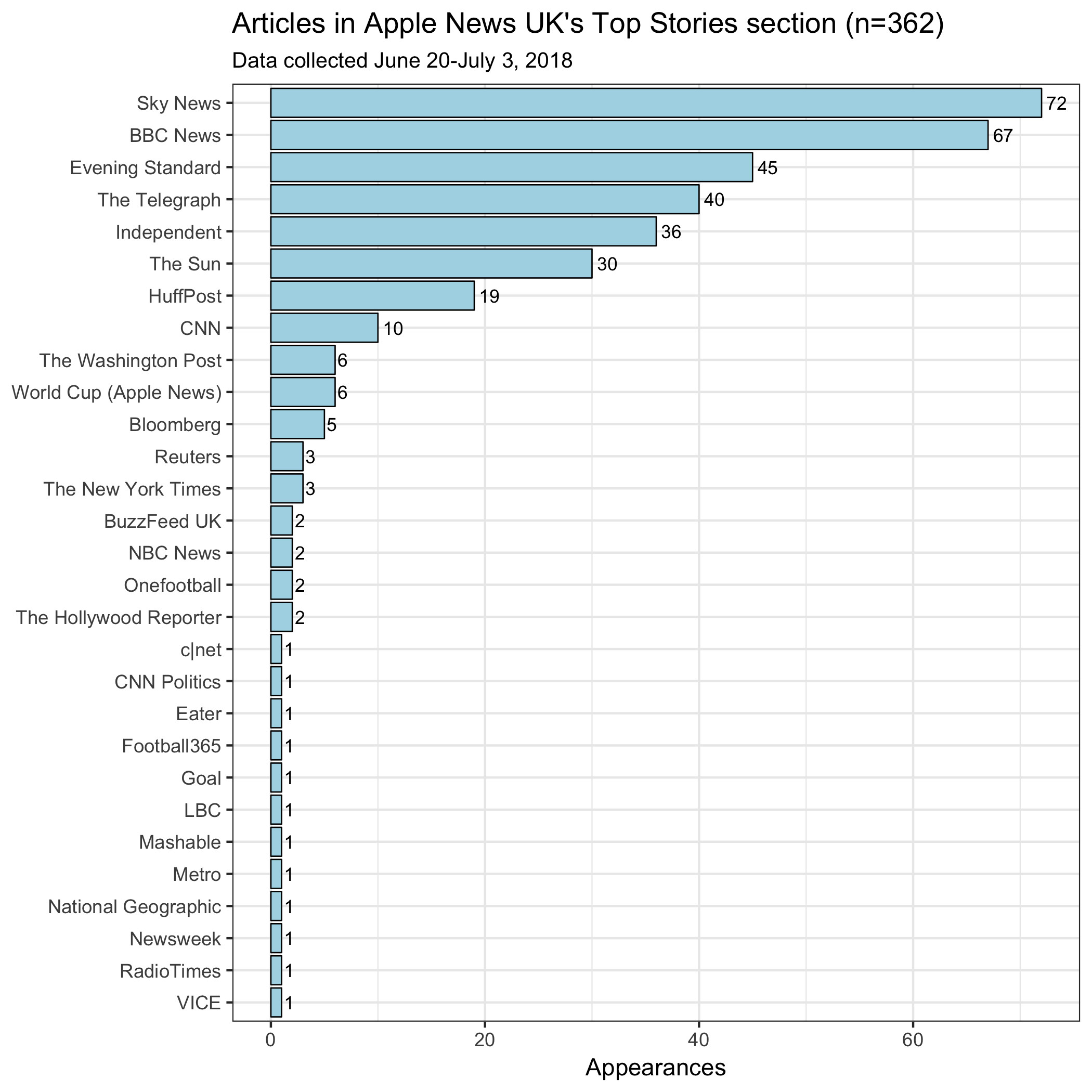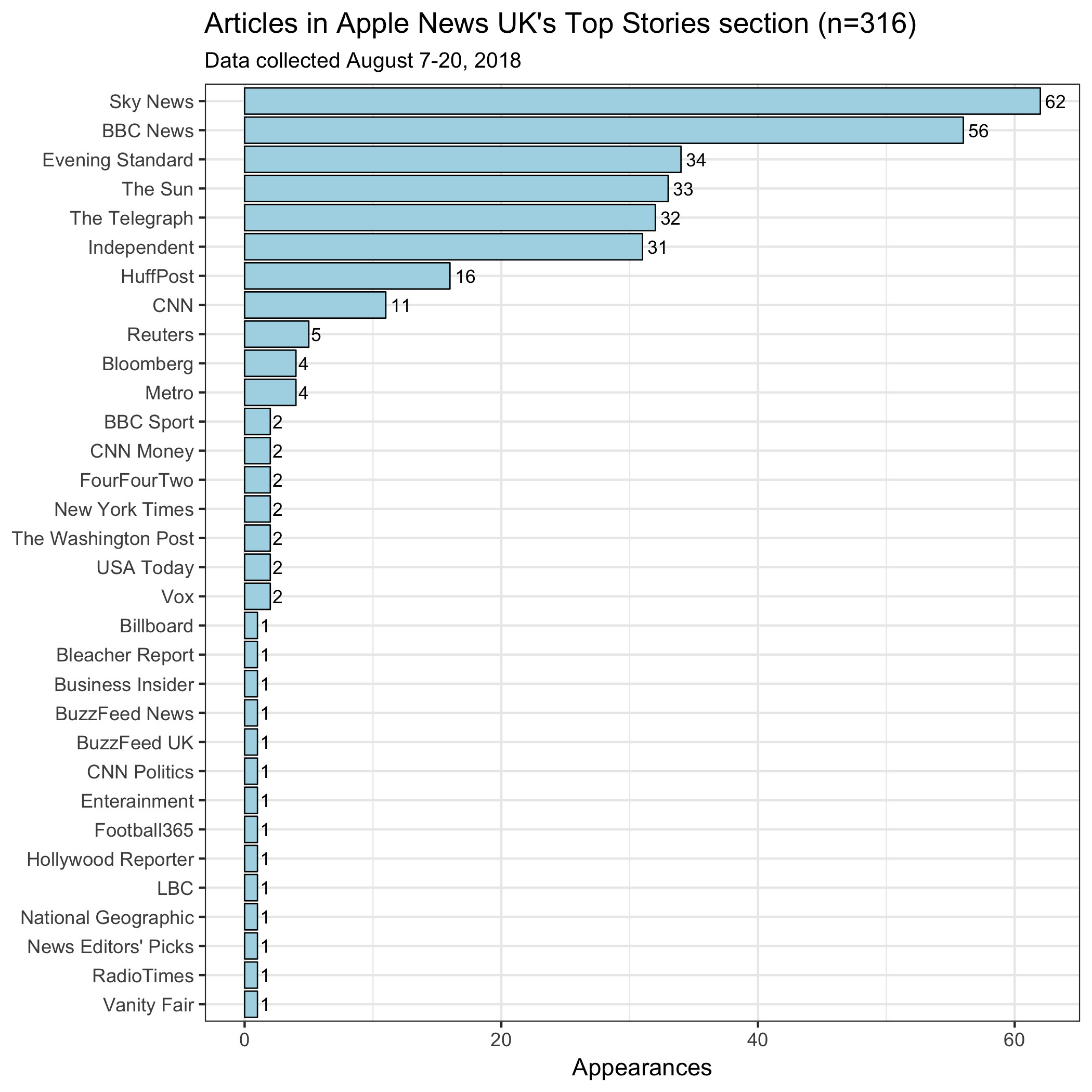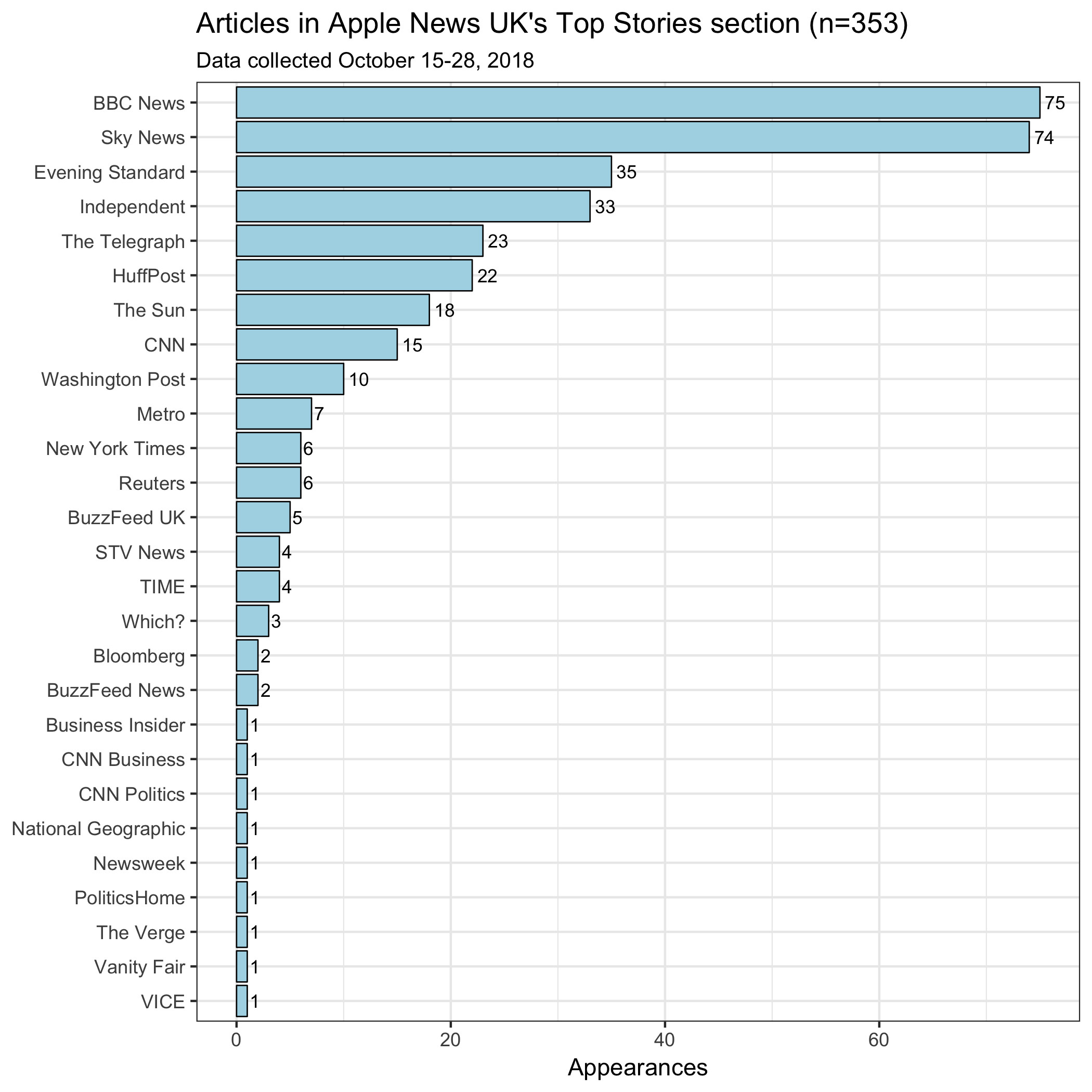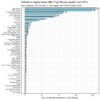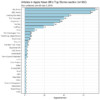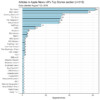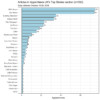Sign up for The Media Today, CJR’s daily newsletter.
Over three-quarters of articles chosen for the human-curated Top Stories section of Apple News UK come from six major publishers, a new Tow Center analysis shows.
As part of ongoing research into platforms and publishers, we looked at a product in the UK that could have lessons for wider markets. Three separate, two-week analyses, conducted two months apart, revealed a recurring pattern of promoting the same group of publishers in the prominent, human-curated section of the app.
Over three-quarters of all articles selected for the Top Stories section came from Sky News, BBC News, ESI Media stablemates the Evening Standard and The Independent, The Telegraph, and The Sun (77 percent combined). Two major broadcasters—BBC News and Sky News—consistently accounted for around 40 percent, or two out of every five, of articles featured; and The London Evening Standard was the third most featured publication in every analysis, averaging 11 percent of all articles, meaning that just three outlets—Sky News, BBC News, and the Evening Standard—consistently accounted for over half of all recommendations in Top Stories.
This habit—and the choice of outlets—supports an earlier Tow analysis of recommendations made by Apple News UK’s editors on @AppleNewsUK’s Twitter feed, which showed a tendency to prioritize a small group of major publishers.
This tendency to prioritize a small band of major publishers—now observed across multiple platforms—raises questions about Apple’s editors’ rationale for boosting certain outlets and downplaying others, a criticism that is frequently leveled at the algorithmically driven platforms to which Apple News has sought to position itself as the antidote.
By limiting editorial recommendations—which deliver huge traffic—to publishers that use Apple’s proprietary page format—which generates minimal revenue—, Apple has put itself in a situation that adversely affects all stakeholders: cash-strapped publishers that cannot afford to trade revenue for traffic shun Apple’s offering, thereby missing out on the brand exposure that comes from being featured in curated sections of the app; Apple’s own editors are then forced to select recommendations from the restricted pool of outlets that are willing to take this risk; consequently, Apple News users are only exposed to news produced from a small group of publishers. (Click slideshow below for larger images.)
ICYMI: Apple’s human editors prefer a few major newsrooms
Methodology: Screen recordings of the Apple News Top Stories were collected twice daily, every day for two weeks over three separate periods this year: June 20–July 3, August 7–20, and October 15–28. All videos were made on an iPhone 7 signed in to a UK iTunes account using iOS’s built-in screen recording facility. Details of each story were then manually entered into a spreadsheet.
In our earlier analysis of editorial choices on other platforms, we noted the prominence of London-based free tabloid The Evening Standard in Apple News UK’s Twitter and newsletter recommendations.
On those platforms, The Standard was the fifth most mentioned news outlet on Apple News UK’s Twitter account and tied for fourth with CNN in its number of newsletter appearances.
Completing the triumvirate, the Standard was the third most featured publisher in each of our analyses of Top Stories chosen by the app’s editors—surpassed only by BBC News and Sky News. Evening Standard stories accounted for 11 percent (or one in every nine) of the 1,031 stories in our analysis.
Given the lack of transparency around the selection process, the reasons for this remain unclear. Whatever their rationale, Apple News UK editors see fit to frequently promote the Standard at every opportunity on every platform they curate.
Apple did not respond to a detailed request for comment.
How do Apple News’s humans pick its top stories, anyway?
Top Stories is arguably the most prominent part of Apple News. It is the first section to display when the app loads, appearing atop the section labelled ‘For You’, and also features in the Apple News widget accessed by swiping right from the homescreen.
Curated sections, such as Top Stories, hold the key to reaching substantially larger audiences through referrals from Apple News, according to multiple reports. Tom Dotan, of The Information, writes that “publishers say the real traffic bursts from News comes by getting featured in either Spotlight or Top Stories.” Likewise, Slate’s Will Oremus states that these “featured sections drive a significant proportion of publications’ total audience on Apple News.” In 2016, NiemanLab’s Ricardo Bilton reported that unique visitors to Bloomberg’s Apple News content “spiked 400 percent” in a month, “thanks to a combination of regular inclusion in the Apple News ‘Top Stories’ section and interest in its breaking news notifications.”
So being featured in Top Stories, as in the image below, is arguably comparable to appearing on the first page of search results on Google, or at the higher end of the Facebook News Feed.
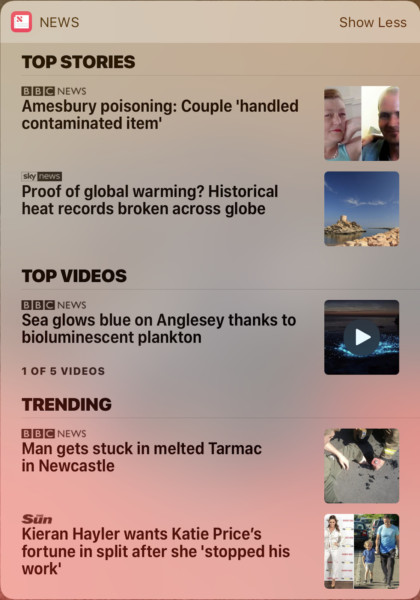
Top Stories featured in the in the Today View of an iOS device
Apple has made a big deal about having human editors as a way of differentiating itself from rivals, Facebook in particular. Speaking at the Fortune CEO Initiative conference in San Francisco, Apple CEO Tim Cook explained, “News was kind of going a little crazy… For Apple News, we felt top stories should be selected by humans to make sure you’re not picking content that strictly has the goal of enraging people.”
But the company has disclosed few details about how and why it selects certain publishers for inclusion in featured sections of the app.
Even senior editors from outlets with close ties to Apple News are in the dark about aspects of the editorial process. Nathalie Malinarich, mobile and new formats editor at BBC News, one of Apple News’s launch partners and one of the outlets with a direct line to the platform’s editors, told Oremus it is “sometimes hard to understand decision-making around the selection of one news org over another.”
Multiple outlets reported that some major publications, including BBC News, have direct access to Apple News editors through dedicated Slack channels, where they can pitch stories. But Apple has attracted criticism for favoring the major players: according to The Information, “Smaller to medium-sized sites say the app tends to favor big mainstream outlets, which get featured prominently when users first sign up for the app and are searching for publications to follow.”
Comparing Apple’s approach to those of its algorithmically driven rivals, Oremus writes: “By hand-picking its publishers and stories, Apple News prioritizes a news source’s reputation and the old-school news value of its content over the propensity of its headlines to garner clicks and likes.” Speaking to Slate, Matt Navarra, a digital media consultant who was previously director of social media at The Next Web, called Apple News “still quite elitist in terms of how they deal with publishers and who they choose to deal with.” (On those terms it is perhaps surprising to see how prominently Apple features The Sun—a News Corp UK-owned red-top tabloid that, while popular, is the least trusted UK news brand, according to the Reuters Institute Digital News Report 2018.)
Insights into Apple’s editorial process are extremely scarce. The New York Times’s recent piece about Apple ahead of the midterms partially described the process through which the tech giant’s US editorial team curates Top Stories for its national audience. A Washington Post story was said to have been selected because it “provided the most context and explanation on why the news mattered.” A “nuanced Miami Herald piece” was chosen because the top editors “wanted a piece that covered the topic thoughtfully.”
If similar rationale is applied to the selection of the UK arm’s Top Stories, are we to assume that the UK editors believe that one of BBC News, Sky News, or the Evening Standard consistently provide more context, explanation and/or thoughtfulness in their journalism than the rest of the publishers in Apple News? It’s possible. But the answer is almost certainly no.
Proprietary formats: Carrot and stick
There may be another factor contributing to the small pool of outlets—Apple News UK’s editors are selecting from the limited subset of content published using the platform’s native, proprietary file format, Apple News Format (ANF).
To stand a chance of being included in Apple News’ Top Stories section, and enjoy the avalanche of traffic that that privilege has proven to deliver, publishers must use ANF instead of directing readers back to their own websites.
Yet Apple’s failure to make this proposition financially viable for cash-strapped publishers has negative ramifications for its own, much-trumpeted, human-led news curation.
Apple’s editors are not sifting through the ‘best’ coverage posted to Apple News; they are sifting through the best coverage published in Apple News Format—a format that many outlets, big and small, have decided to shun. The Guardian and The Mirror, two major outlets that Apple News’ UK editors frequently promoted on Twitter before they stopped publishing in ANF, maintain active Apple News channels—they just don’t publish in the platform’s native format anymore. They never appear in Top Stories.
Platforms have pitched variations on Apple’s do-it-for-the-exposure proposition—the one that typically involves giving away expensive content for free in exchange for an avalanche of traffic and brand exposure but minimal hard cash—many times before, of course. Google wants publishers to use AMP so news audiences maximize their time using Google. Facebook wants publishers to use Instant Articles so news audiences maximize their time in the walled garden of Facebook’s mobile app. Apple News, similarly, wants publishers to use ANF so news audiences maximize their time in Apple News.
Everyone loses
Apple has been eager to make its human editors part of its pitch to news consumers—and newsrooms. But in doing so, the trillion-dollar company has emphasized one of its product’s shortcomings. Apple’s apparent reluctance to make Apple News financially viable for cash-strapped news organizations has forced many to pass on Apple’s offer. This, in turn, ties the hands of Apple’s own editors because it limits the pool of journalism from which they can choose for curated sections of the app. Thus, Apple’s customers get a subpar version its product—one where UK editors are sourcing over half of Top Stories from the same three publishers. The logic is as follows:
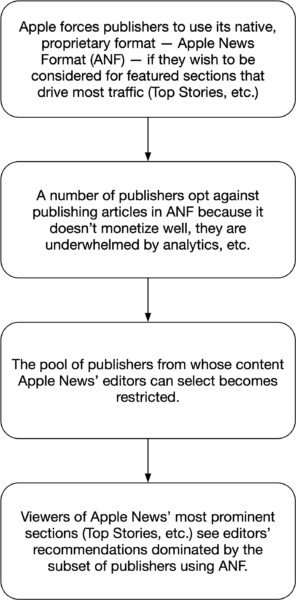
Every stakeholder in Apple News is adversely affected by its narrow palate:
- Platform: The depth and quality of Apple News’ product is hamstrung because the limited range of publishers using its proprietary format severely limits the range of journalism from which its editors can choose;
- Audience: Readers accessing journalism via the most prominent areas of Apple News’ product—iOS’ Today screen widget and the Top Stories section that greets users on launching the app—are exposed to news from a severely restricted range of publishers;
- Publishers: News outlets are placed between a rock and a hard place. Those that have concluded that publishing in Apple’s proprietary format isn’t financially viable stand no chance of benefiting from the massive traffic spikes Apple can deliver. Concurrently, those that conclude they are willing to take the risk and get into bed with tech companies are forced to take a huge financial hit, gambling on the possibility of reaching new audiences, building brand loyalty and monetizing down the line. In other words, the trillion dollar tech company gives struggling news outlets a choice: Traffic or revenue, but not both.
Even with humans curating, the uneasy relationship between news organizations and tech companies remains dysfunctional at best.
Has America ever needed a media defender more than now? Help us by joining CJR today.



